In 2025, living room lighting trends showcase a blend of sculptural designs and layered illumination techniques. Key elements include artistic fixtures that make bold statements, along with adjustable lighting options for varied moods. Natural and biophilic influences dominate, incorporating organic shapes and eco-friendly materials. Smart lighting technology enhances user experience by enabling personalized settings. Vintage and retro styles also make a comeback, creating unique, inviting spaces. Discover how these trends can transform interiors and elevate ambiance further.
Key Takeaways
- Sculptural and artistic lighting, featuring avant-garde designs, serves as striking focal points that transform living room aesthetics in 2025.
- Layered lighting schemes combining ambient, task, and accent sources provide dynamic versatility for different activities and settings.
- Biophilic influences, with organic shapes and earthy color palettes, create calming environments that connect indoor spaces with nature.
- Smart and sustainable lighting solutions enhance functionality and convenience while promoting energy efficiency and reducing carbon footprints.
- Vintage and retro design elements, coupled with modern materials, provide unique character and individuality to contemporary living room spaces.
Sculptural and Artistic Lighting
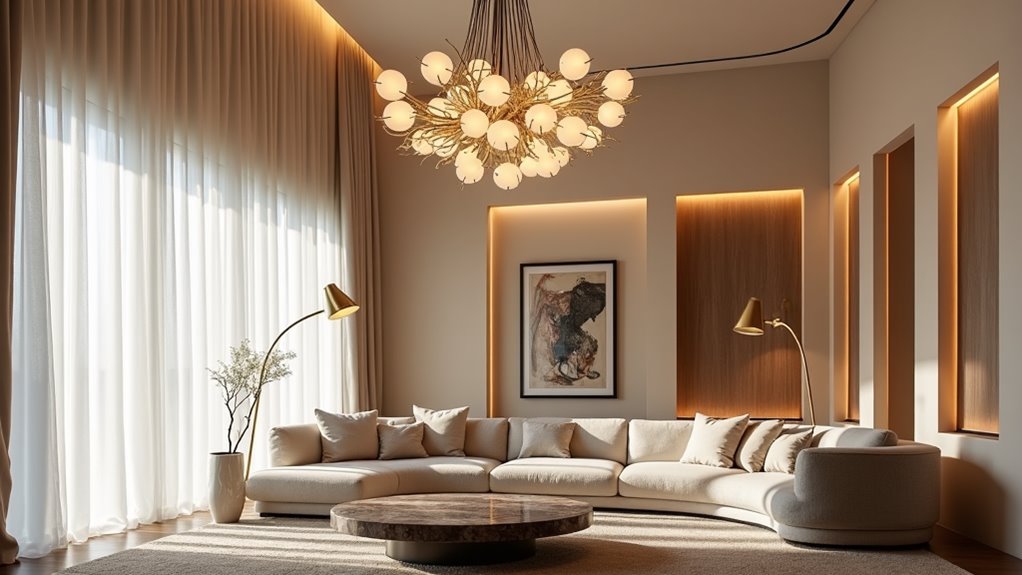
As the quest for distinctive home aesthetics continues, sculptural and artistic lighting emerges as a transformative element in modern living rooms. These fixtures not only illuminate but embody artistic expression and sculptural integrity, often standing as statement pieces that spark conversation.
Designers favor grand, fluid shapes inspired by nature, such as leafy forms and tree branches, as well as geometric patterns, melding organic beauty with bold statements. A mix of materials—textured glass, brushed metals, and artisanal ceramics—enhances tactile richness, while warm metallic finishes dominate. Warm ambient lighting becomes integral to the overall experience, effectively complementing these striking designs. The importance of effective lighting lies in its ability to seamlessly combine function and form, enhancing the overall atmosphere of the living space.
Sculptural lighting serves as focal points, captivating attention even when unlit, thereby adding depth and drama to contemporary spaces. This trend underscores a growing desire for unique, handcrafted pieces that resonate with personal identity.
Layered Lighting Schemes
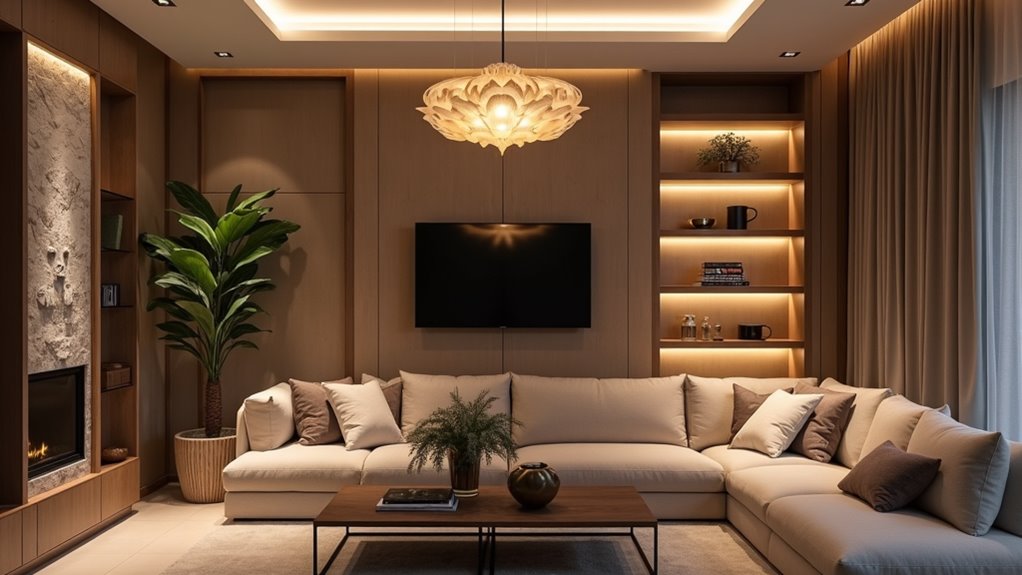
Layered lighting schemes represent a crucial evolution in contemporary interior design, integrating multiple lighting types to enrich the living room experience.
Layered lighting schemes are revolutionizing interior design by seamlessly blending various lighting types to enhance every aspect of the living room.
By incorporating ambient light styles, task light placement, and accent lighting, designers can create a dynamic atmosphere that adapts to various activities.
- Ambient lighting establishes a soft, inviting foundation.
- Task lighting focuses illumination on work areas, enhancing functionality and reducing eye strain.
- Accent lighting highlights artwork, architectural features, or decor, adding visual intrigue.
- Dimmable fixtures provide flexibility, allowing smooth transitions from bright, engaging settings to intimate, relaxing moods.
Natural and Biophilic Influences
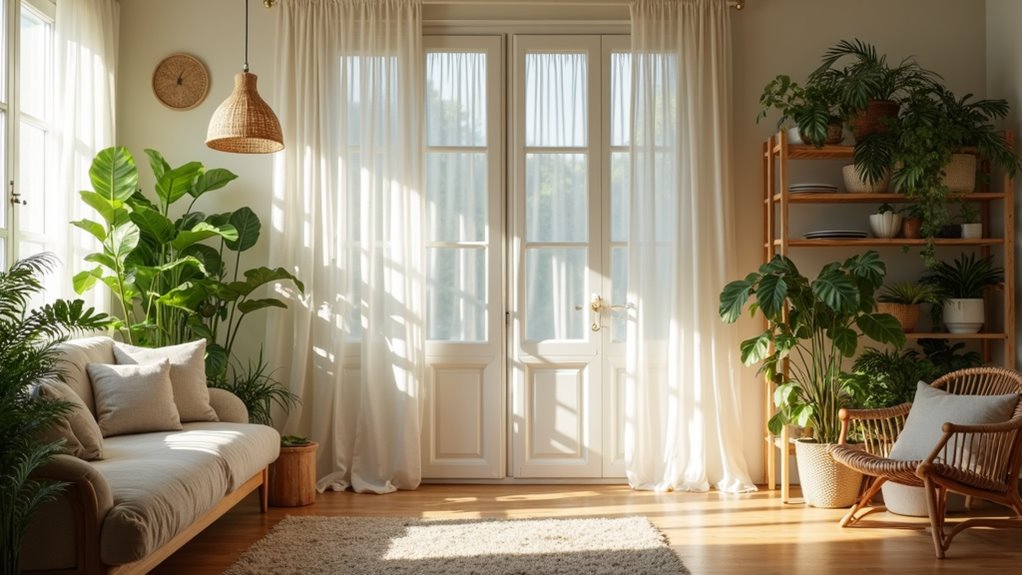
The layered lighting schemes that enrich modern living spaces can seamlessly integrate natural and biophilic influences, enhancing overall well-being.
Biophilic lighting mimics natural sunlight patterns, using color temperature adjustments that align with the sun’s cycle, thus promoting healthier circadian rhythms.
Fixtures designed with organic shapes—evoking branches or leaves—introduce a sense of calm while enhancing tranquility.
The trend toward eco-friendly materials like rattan and reclaimed wood infuses spaces with natural warmth, offering a tactile and luxurious finish.
Earthy color palettes dominated by warm browns and deep greens further foster a connection with nature.
Collectively, these elements create inviting environments that blur indoors and outdoors, allowing residents to experience the soothing effects of nature within their own homes.
Smart and Integrated Lighting
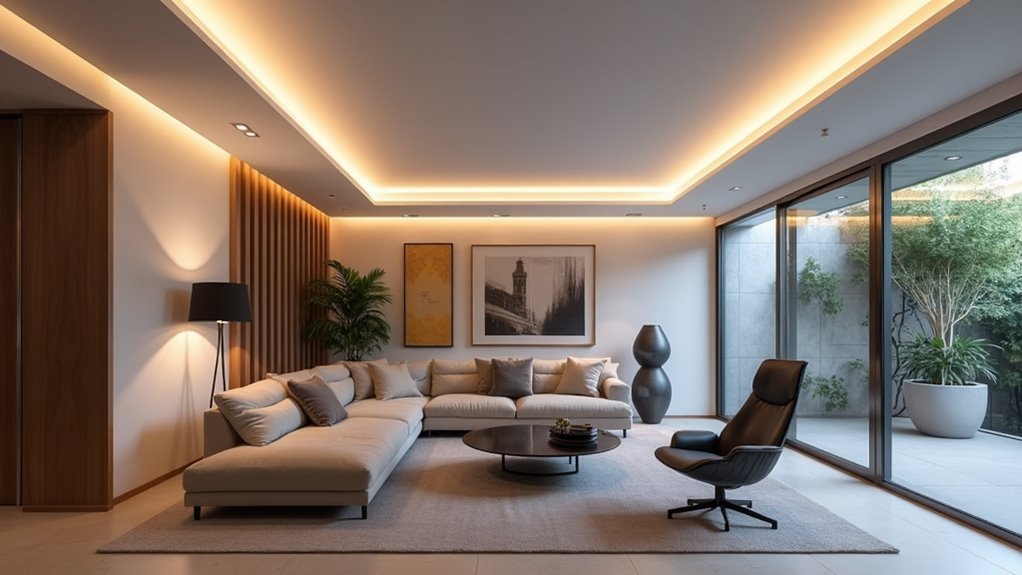
Transforming living spaces, smart and integrated lighting emerges as a pivotal trend in 2025, blending technology with design to enhance functionality and aesthetics.
This evolution in smart home automation emphasizes user-friendly interfaces, enabling effortless control over lighting environments.
Key features include:
- Voice control integration with virtual assistants for hands-free operation.
- Mobile apps facilitating remote adjustments of brightness and color temperature.
- Personalized lighting scenes tailored for activities like “movie night.”
- Energy-efficient LED technology, contributing to reduced household consumption.
The seamless integration of lighting with other smart devices cultivates a holistic ambiance, where automated adjustments complement residents’ routines and preferences while promoting sustainability.
As such, this trend positions itself as essential for modern living rooms, reflecting both convenience and growing environmental consciousness.
Vintage and Retro Revival
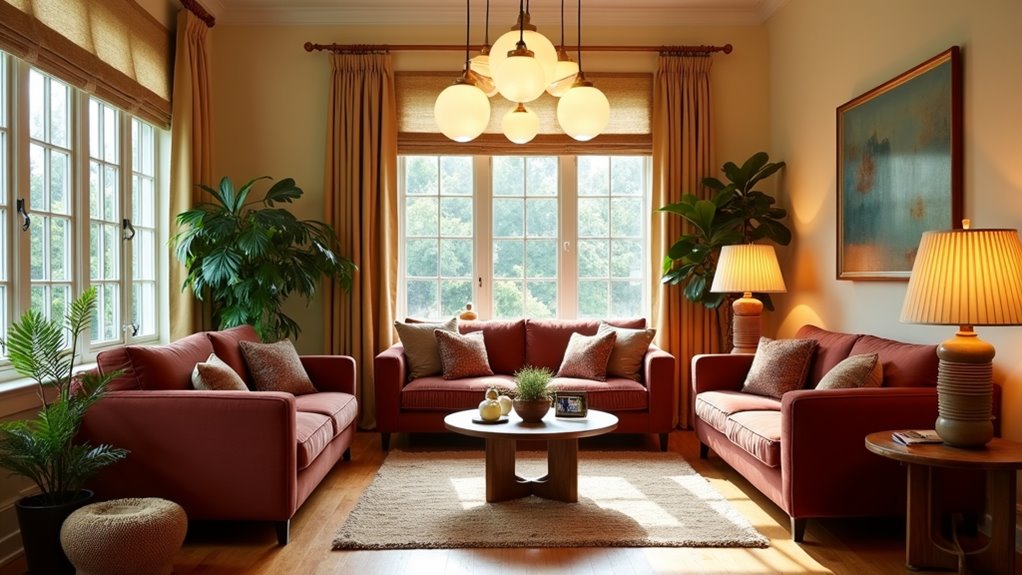
As the design landscape of 2025 emerges, a notable shift towards vintage and retro influences redefines living room aesthetics.
The enduring appeal of mid-century modern elements, characterized by their clean lines and organic shapes, complements the rising popularity of Art Deco’s luxurious materials and geometric patterns.
These timeless design elements not only evoke nostalgia but also enhance contemporary interiors, illustrating a seamless blend of past and present.
Timeless Design Elements
An increasing fascination with vintage and retro design elements can be observed in living room lighting trends for 2025. This revival emphasizes timeless elegance while weaving historical narratives into modern aesthetics.
- Art Deco fixtures exhibit symmetrical lines and luxurious materials like brass and glass.
- Victorian-inspired design features ornate details and intricate metalwork, elevating everyday spaces.
- 70s lighting brings bold shapes and earthy tones, reinvigorating atmosphere with warmth.
- Unique vintage pieces offer individuality and serve as conversation starters.
As designers integrate these elements, the interplay of past and present creates spaces that resonate with character. Ultimately, this approach enriches contemporary interiors by celebrating their historical roots and craftsmanship.
Mid-Century Modern Influence
Mid-Century Modern (MCM) lighting emerges as a focal point of the vintage and retro revival for 2025, captivating designers and homeowners alike with its distinctive aesthetic.
Characterized by clean lines and geometric shapes, MCM lighting features iconic fixtures like Sputnik chandeliers and globe pendants, which incorporate both function and style. These designs often exhibit a blend of organic forms and natural materials with modern elements, creating visually engaging pieces that provide practical illumination.
The minimalist approach inherent in MCM style fosters an uncluttered aesthetic, highlighting each fixture’s elegant form. As warmer metals and rich woods resurface in popularity, MCM lighting continues to resonate, seamlessly integrating into contemporary living spaces while maintaining its timeless appeal.
Art Deco Resurgence
The resurgence of Art Deco lighting in 2025 captures a renewed fascination with vintage aesthetics, seamlessly merging iconic design with contemporary living.
This revival emphasizes the Art Deco context, highlighting luxurious materials alongside bold geometries that evoke glamour and sophistication. Homeowners are drawn to distinctive fixtures that encourage individual expression through layered lighting strategies.
- Chandeliers adorned with chrome and glass for opulence
- Sleek wall sconces featuring geometric designs
- Statement floor lamps with elegant curves and metallic finishes
- Stylish table lamps showcasing unique bases and vivid patterns
This trend reflects a broader departure from minimalism, offering a rich narrative that combines nostalgia with modern elegance, perfect for any luxurious living room space.
Curves and Organic Shapes
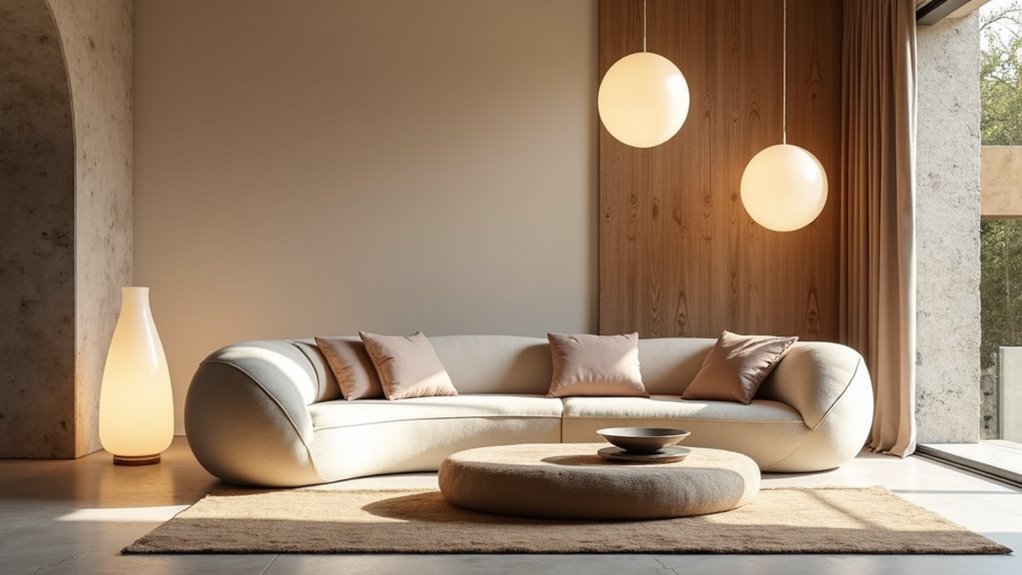
The emerging trend of curves and organic shapes in lighting design for 2025 emphasizes flowing and fluid designs, drawing inspiration from the natural world.
This approach introduces a sense of softness to interiors, effectively countering the sharp lines of contemporary furnishings.
Additionally, the incorporation of whimsical elements adds personality and charm, transforming lighting fixtures into expressive art pieces that enhance the overall ambiance.
Flowing and Fluid Designs
Flowing and fluid designs in lighting, characterized by curves and organic shapes, are emerging as a defining trend for 2025. These new fixtures embrace fluid dynamics and organic aesthetics, offering a serene connection to nature. This trend manifests in various sophisticated forms, enhancing both functionality and artistry within home interiors:
- Lighting fixtures shaped like smooth pebbles or twisting branches evoke tranquility.
- Soft curves introduce movement, balancing stark angular furnishings.
- Sculptural chandeliers provide artistic focal points while mesmerizing with their asymmetrical beauty.
- Textured glass and natural materials create tactile, flowing silhouettes that harmonize with ambient light diffusion.
This progressive design approach not only elevates visual appeal but also fosters a calm atmosphere, making every room feel more inviting and elegant.
Softness in Interiors
Softness in interiors is increasingly defined by the integration of curves and organic shapes in lighting design.
This trend embodies flowing lines and natural forms, fostering a harmonious connection to the environment. Inspired by elements like drops and waves, lighting fixtures create an inviting atmosphere through soft color palettes that enhance tranquility.
The use of tactile materials such as wood, stone, and fabric further amplifies this softness, as hand-blown glass and ceramics contribute to unique aesthetics.
Chandeliers with organic silhouettes serve as statement pieces that double as art, adding character to spaces while promoting a soothing ambiance.
Ultimately, these designs cultivate environments that are both serene and restorative, balancing angular architectural elements with gentle, organic forms.
Embracing Whimsical Elements
Whimsical elements in lighting design for 2025 are captivating audiences with their artistic and playful qualities. This trend emphasizes curves and organic shapes, transforming lighting fixtures into imaginative sculptures that enhance interior spaces.
These playful designs often evoke whimsical creativity and celebrate aesthetics that connect to nature, adding a unique charm to living rooms.
- Flowing lines that mimic the gentle movement of waves.
- Asymmetrical chandeliers reminiscent of blooming flowers.
- Pebble-shaped fixtures evoking the tranquility of natural landscapes.
- Elegant silhouettes that diffuse light softly, creating an inviting atmosphere.
Avant-Garde Chandeliers
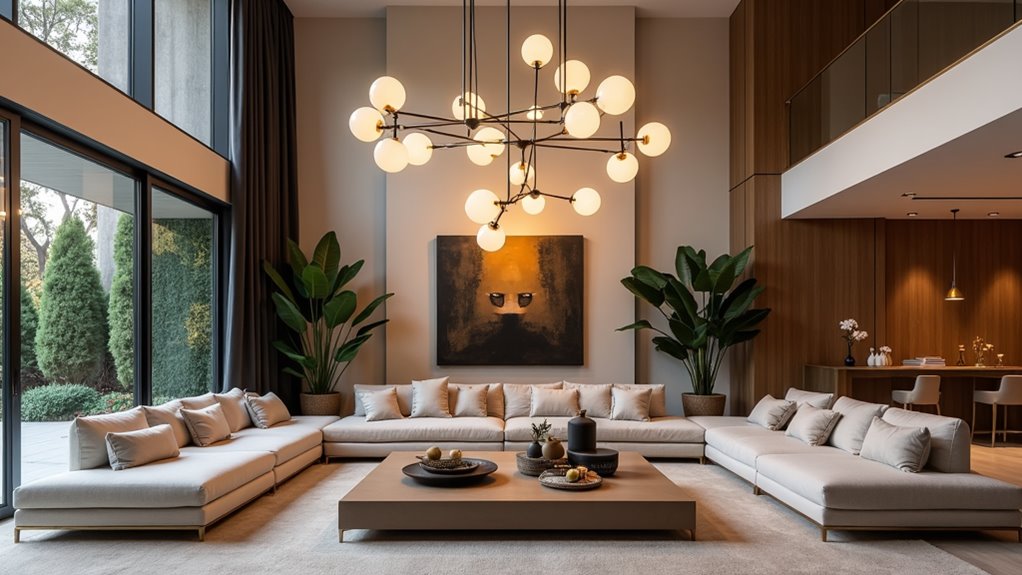
As the boundaries between art and functionality continue to blur, avant-garde chandeliers are emerging as pioneering masterpieces in interior lighting design.
These fixtures exemplify avant garde aesthetics, transforming traditional lighting into sculptural art pieces. With fluid and organic shapes alongside striking geometric forms, they act as bold focal points within any space. Designs often feature asymmetrical layouts, layering that adds depth, and unexpected combinations of materials, pushing the envelope of creative expression.
Illuminated or not, these chandeliers captivate attention, cementing their role as conversation starters. The trend towards oversized and sculptural designs signifies a newfound emphasis on making dramatic statements, reshaping the living room landscape by challenging conventional notions of lighting and decor.
Textured and Mixed Materials
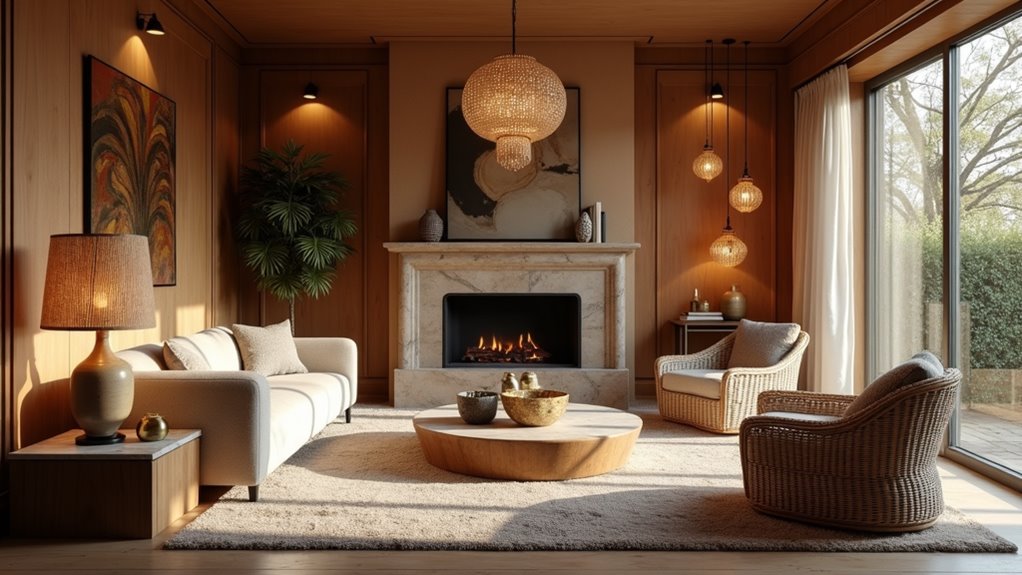
The trend towards textured and mixed materials in lighting design reflects a growing appreciation for complexity and warmth in living spaces.
By embracing a variety of materials such as wood, glass, and metal, designers are layering textures that enhance visual interest and create a harmonious balance within decor.
This approach not only emphasizes tactile elements but also connects disparate design styles, fostering a more cohesive aesthetic.
Embracing Material Variety
In 2025, the trend of embracing material variety in living room lighting reflects a sophisticated interplay of textures and finishes that redefine contemporary aesthetics.
This evolution showcases sustainable sourcing and artisanal craftsmanship, highlighting the importance of eco-friendly materials.
Key design elements include:
- Raw wood paired with textured glass for an organic touch
- Hand-blown ceramic shades that capture artisanal elegance
- Reclaimed metal accents providing a harmony of vintage and modern
- Soft linen or cotton elements that enhance warmth
These combinations not only embrace natural imperfection but also champion sustainability, allowing for custom, visually engaging pieces.
The rise of mixed materials signifies a transition toward fixtures that are both stylish and responsible, captivating homeowners with their unique character and tactile richness.
Layering Textures Aesthetically
Embracing material variety naturally leads to an exploration of texture in living room lighting, where the aesthetic layering of textures plays a pivotal role in shaping modern decor.
In 2025, lighting designs emphasize the use of natural materials—linen, raffia, and bamboo—introducing warmth and tactile appeal.
Textured lampshades, particularly in patterned fabrics, permit curated illumination, enhancing aesthetic harmony throughout the space. The combination of diverse materials, such as wood and metal or glass and ceramics, creates depth and visual interest, enhancing the overall ambiance.
Furthermore, sculptural lighting fixtures with organic shapes characterize this trend, infusing artfulness into the room.
Texture layering in lighting not only elevates design but also harmonizes various elements, creating a cohesive narrative for contemporary living spaces.
Enhanced Mood With Color-Adjustable Options
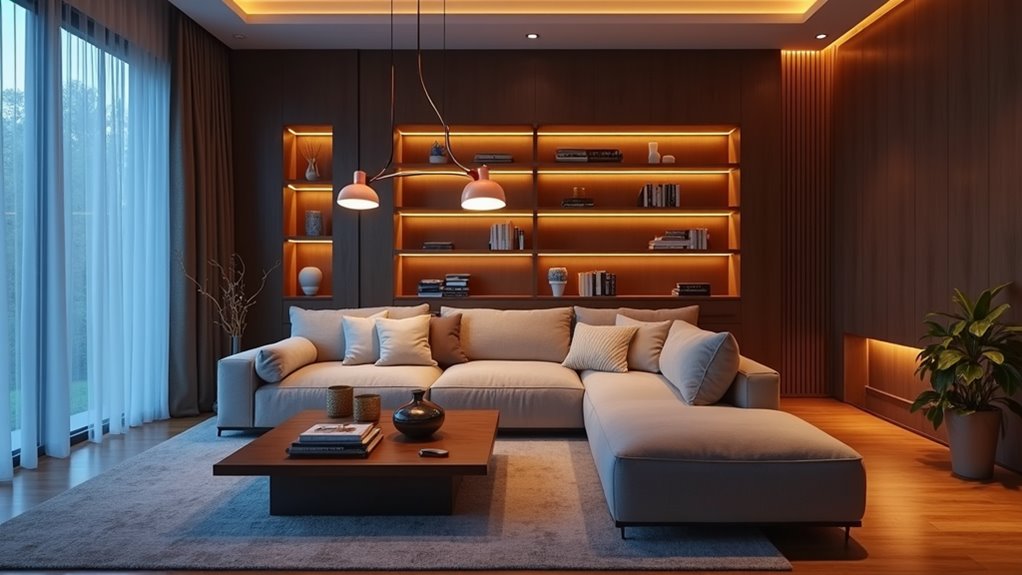
With the increasing recognition of the connection between lighting and emotional well-being, color-adjustable options have emerged as vital components in modern living room design.
These innovative systems adapt color temperature throughout the day, enhancing the ambient mood to support natural circadian rhythms.
- Morning light mimics the freshness of dawn, promoting alertness.
- Evening tones shift to warm hues, inviting relaxation and calm.
- RGB technology creates vivid spaces, from lively gatherings to serene atmospheres.
- Smart controls allow for effortless scene adjustments tailored to specific activities.
The interplay of color temperature deeply influences daily emotions, ushering in joy or tranquility, thereby establishing a dynamic setting that transcends mere aesthetics to foster psychological well-being.
Reconnecting With Nature Through Design
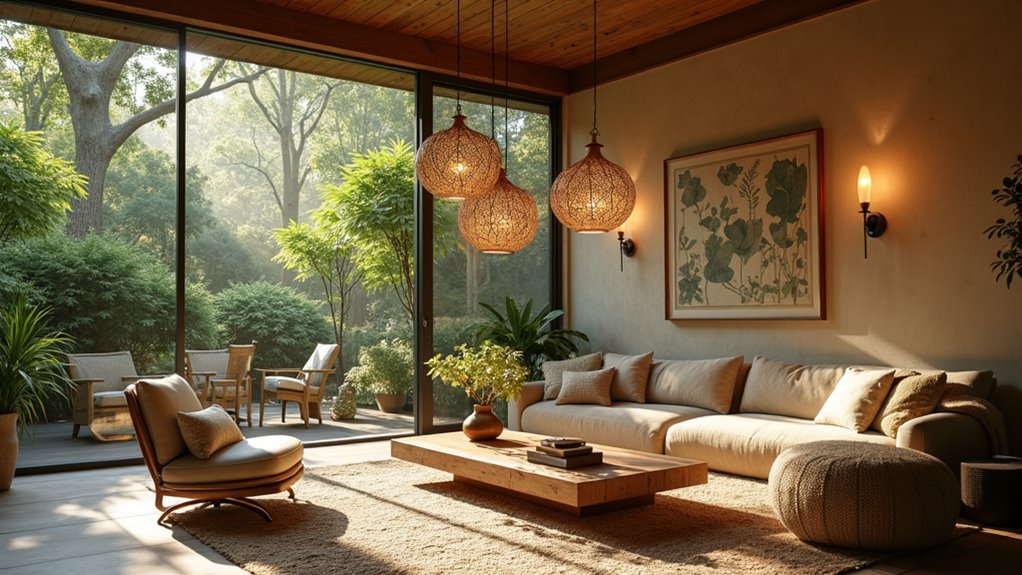
The growing emphasis on emotional well-being through lighting naturally leads to a broader exploration of nature-inspired design elements in living room aesthetics. This trend highlights nature-inspired colors such as earthy browns and greens that evoke a sense of tranquility and balance.
Fixtures crafted from raw materials like rattan, driftwood, and stone not only embrace natural imperfections but also reflect a commitment to sustainability. Designs featuring organic patterns and flowing shapes mimic the contours of nature, promoting fluid harmony within urban environments.
Additionally, maximizing natural light through the strategic use of windows and sheer fabrics enhances mood while supporting the body’s circadian rhythm. Overall, this integration of biophilic design fosters a deeper connection to nature through well-considered lighting choices.


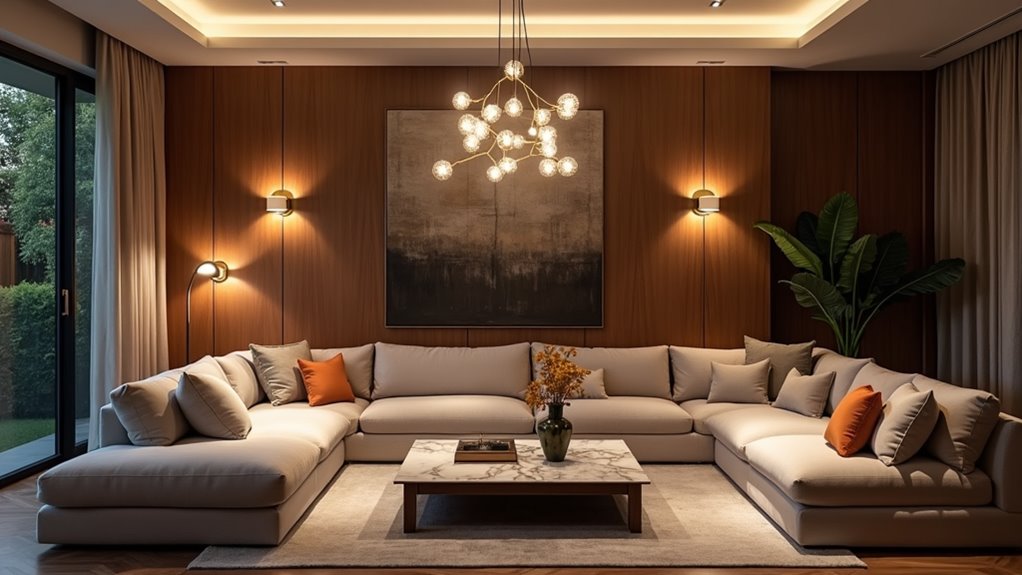
Bài viết cùng chủ đề:
Top 5 Living Room Track Lighting Fixtures for Modern Homes
7 Tips for Creating Stunning Living Room Cove Lighting Designs
3 Brilliant Ideas for Living Room Floor Lighting
7 Tips for Perfect Living Room Ceiling Recessed Lighting
10 Brilliant Living Room Overhead Lighting Ideas
Top 5 Semi-Flush Living Room Lighting Fixtures for 2025